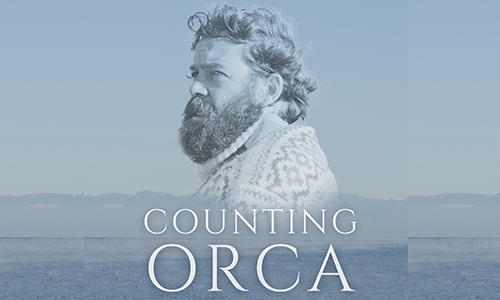||| ORCASIONAL MUSINGS BY STEVE HENIGSON |||
If you ever venture up to the north end of North Beach Road, take a left into Smuggler’s Villa for a quick tour of Mike Stolmeier’s small collection of Studebaker Avanti automobiles. There are always at least two of them there, parked in the guest-registration lot, and there’s another awaiting completion at an Orcasian auto-repair shop.
While you’re there, look around at the Smuggler’s Villa accommodations. It’s easy to see that Mike has a strong aesthetic sense. The buildings are nice to look at and comfortable to occupy, there’s a picture at the bottom of the swimming pool, you’re right next to the interesting marina that Orcasians call “the big ditch,” and there’s a small flower garden filled to the brim with beauty. Mike’s Avanti cars fit in perfectly with the overall effect.
Many knowledgeable people think that the Studebaker Avanti was the most aesthetically satisfying car ever designed. It has a beautiful shape, smooth and unadorned lines, and perfect proportions. The first one came off of Studebaker’s assembly line in 1962, and it was a design way ahead of its time. Because of its radical and, um, avant-garde styling, the Avanti didn’t sell well, so it proved to be the Studebaker company’s swan song.

Studebaker 1947 Starlight Coupe
The Studebaker company built vehicles from 1852 through 1967, starting with those sturdy and indefatigable Conestoga wagons which brought Easterners out to populate, placer-mine, and farm the wild and wide-open West. Studebaker began making automobiles in 1902, and its cars soon developed a reputation for sturdiness and longevity, but after the end of World War Two the company faced very stiff competition from Chrysler, Ford, and General Motors. To overcome these rivals, Studebaker’s managers decided to concentrate on aesthetics, so they hired Raymond Loewy, the ablest and most famous industrial designer of the time, to shape their product line.
Raymond Loewy had been born in France, in 1893. He had served as a captain in France’s army during World War One, had been wounded in action, and had been awarded the Croix de Guerre for his gallantry. But as soon as the war was over, and he had been discharged, he moved to New York City to exercise his considerable talents in the world’s center of art and commerce.

Studebaker 1953 Champion Coupe
Loewy began his Studebaker campaign with the 1947 model year. He produced a car that delivered unprecedented visibility to both driver and passengers, and, at the same time, presented an astounding external shape to the people who saw it go by. Then, year by year, Loewy refined the car’s features and appearance. As an example of this, near the Avanti cars at Smuggler’s Villa, Mike Stolmeier also parks a Loewy-designed 1951 Studebaker Starlight Coupe, the car about which people said, “you couldn’t tell whether it was coming or going.” The culmination of this series came in 1953, when Loewy presented Studebaker’s customers with a low, smooth, undecorated shape which, even today, is considered one of the most beautiful automobiles ever built.
Raymond Loewy was at the peak of his career, when he designed Studebaker’s automotive lines from 1947 through 1963, but the same was not true for Studebaker itself. Poor management practice was destroying what had been one of the North American continent’s better automobile manufacturers, and, in the end, nothing that Loewy could do would make any difference. His final effort was the Avanti, and it held off disaster for just about a year, during which only 5,800 of the cars were made.

Studebaker 1962 Avanti
But people with a strong aesthetic sense, for instance Mike Stolmeier, kept the beautiful car in mind, and, when there was money enough, finally bought one; or, as in Mike’s case, acquired three or four of them. And here they are on Orcas Island, awaiting your viewing pleasure. Seek them out: Seeing them is worth the effort.
(Note that when Studebaker went out of business, the Avanti didn’t die off right away. The design passed through the hands of five different manufacturers, until its final demise in 2006.)
**If you are reading theOrcasonian for free, thank your fellow islanders. If you would like to support theOrcasonian CLICK HERE to set your modestly-priced, voluntary subscription. Otherwise, no worries; we’re happy to share with you.**









I happened to stumble on these last time I was on Orcas. Thanks for the backstory. Makes it even more enjoyable.
Thanks, Steve, for your enjoyable Musings on Mike Stolmeier’s Studes. Two uncles of mine sold Studebakers in Texas and new Mexico in the 1950s. My favorite car was always the 1950 bullet-nose Champion, but every Stude was a work of art.
My daily walk takes me by the Stolmeir SStudsebaker Industrial Com,plexNot long ago I witnessed a tow truck person prerspon fastening the copper colored Avanti to the bed of his truck and then sounding the authoritative engine before taking off. I surveyed the parking lot at Smuggler’s and saw parked there only the pig nosed 1947bvStud and considered the possibiliity that Mike was cashing in due to the COVID lockdown. (I know that the late Willie Thomas cashed in his 68 Jaguar XKE for over twnety grand ) I am glad the Avanti is only awaiting repair.
Thanks Steve for the interesting article and photos of the beautiful Studebakers designed by Raymond Loewy. Will go by and have a look at them. In 1956 I started working as a stewardess for United Airlines, flying on Convairs, DC-4″s, 6-‘s, and 7-‘s. Then in 1957 we were anticipating the new DC-8 jets arriving. The big word from United was that the interior of the planes, plus our new uniforms were designed by the famous industrial designer Raymond Loewy. The new interior and uniform color was LOEWY BLUE.
Fun remembrances – Thanks , Mike & Steve! I learned to drive on my Mom’s ‘53 Studebaker Champion, standard 3-speed stick. And it was a hard break for her to give it up, trading it in for a ‘66 Mustang!
Oh, the Avanti takes my breath away whenever I see it. The kids I’m riding with think I’m nuts, but wow!